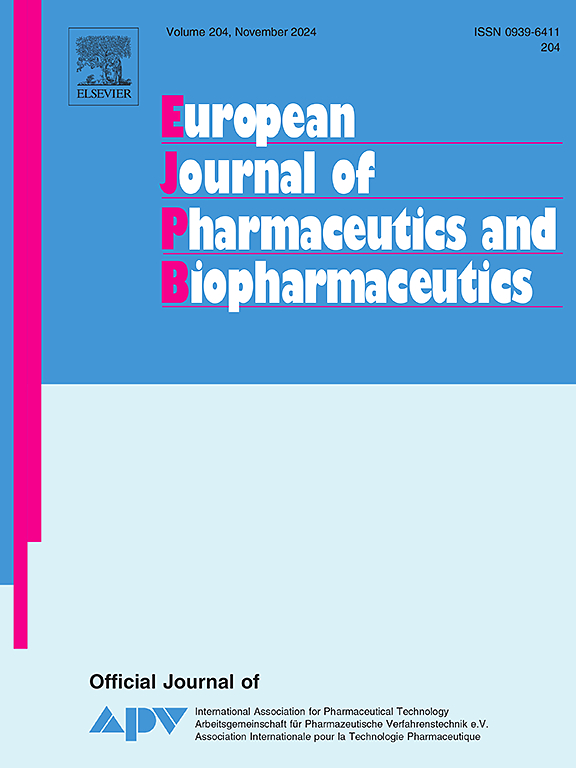Fabrication and characterization of a multifunctional hyaluronic acid-based microneedle system for diabetic wound healing
IF 4.4
2区 医学
Q1 PHARMACOLOGY & PHARMACY
European Journal of Pharmaceutics and Biopharmaceutics
Pub Date : 2025-03-31
DOI:10.1016/j.ejpb.2025.114704
引用次数: 0
Abstract
Diabetes mellitus (DM)-associated wounds, characterized by chronic bacterial infections and elevated glucose levels, present significant challenges to effective healing. To overcome these issues, a novel transdermal drug delivery system was developed, integrating microneedles (MNs) with biofilm-penetrating capability, the wound-healing properties of hyaluronic acid (HA), the antibacterial effects of silver nanoparticles (AgNPs), and the glucose-lowering action of insulin (Ins). Named HAMNs@AgNPs-Ins, this system demonstrated optimal morphological characteristics, robust mechanical strength, and 100 % skin penetration efficiency. It exhibited sustained antibacterial activity in vitro, ensured skin safety, and provided controlled, steady blood glucose reductions, achieving a 72.29 % reduction at 8 h, compared to the sharp decline seen with subcutaneous injection. Additionally, wound healing experiments showed a significant improvement in the healing rate of 89.66 ± 1.34 % in the HAMNs@AgNPs-Ins group, compared to 48.19 ± 9.03 % in the control group. These results underscore the potential of HAMNs@AgNPs-Ins as an effective treatment for DM-associated wounds.

用于糖尿病伤口愈合的多功能透明质酸微针系统的制备和表征
糖尿病(DM)相关伤口的特点是慢性细菌感染和血糖升高,这给伤口的有效愈合带来了巨大挑战。为了克服这些问题,我们开发了一种新型透皮给药系统,该系统集成了具有生物膜穿透能力的微针(MNs)、透明质酸(HA)的伤口愈合特性、银纳米粒子(AgNPs)的抗菌作用以及胰岛素(Ins)的降糖作用。该系统被命名为 HAMNs@AgNPs-Ins,具有最佳的形态特征、强大的机械强度和 100% 的皮肤渗透效率。它在体外表现出持续的抗菌活性,确保了皮肤安全,并提供了可控、稳定的血糖降低效果,8 小时后血糖降低了 72.29%,而皮下注射时血糖会急剧下降。此外,伤口愈合实验显示,HAMNs@AgNPs-Ins 组的伤口愈合率为 89.66 ± 1.34%,与对照组的 48.19 ± 9.03% 相比有显著改善。这些结果表明,HAMNs@AgNPs-Ins 具有有效治疗 DM 相关伤口的潜力。
本文章由计算机程序翻译,如有差异,请以英文原文为准。
求助全文
约1分钟内获得全文
求助全文
来源期刊
CiteScore
8.80
自引率
4.10%
发文量
211
审稿时长
36 days
期刊介绍:
The European Journal of Pharmaceutics and Biopharmaceutics provides a medium for the publication of novel, innovative and hypothesis-driven research from the areas of Pharmaceutics and Biopharmaceutics.
Topics covered include for example:
Design and development of drug delivery systems for pharmaceuticals and biopharmaceuticals (small molecules, proteins, nucleic acids)
Aspects of manufacturing process design
Biomedical aspects of drug product design
Strategies and formulations for controlled drug transport across biological barriers
Physicochemical aspects of drug product development
Novel excipients for drug product design
Drug delivery and controlled release systems for systemic and local applications
Nanomaterials for therapeutic and diagnostic purposes
Advanced therapy medicinal products
Medical devices supporting a distinct pharmacological effect.

 求助内容:
求助内容: 应助结果提醒方式:
应助结果提醒方式:


